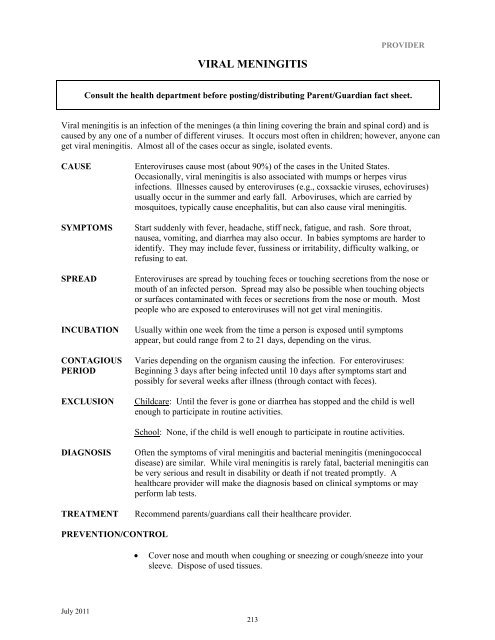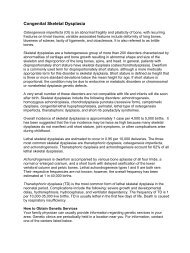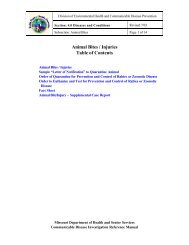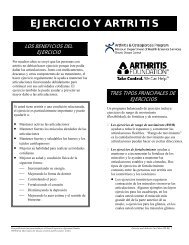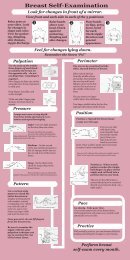Prevention and Control of Communicable Diseases - Missouri ...
Prevention and Control of Communicable Diseases - Missouri ...
Prevention and Control of Communicable Diseases - Missouri ...
Create successful ePaper yourself
Turn your PDF publications into a flip-book with our unique Google optimized e-Paper software.
July 2011<br />
VIRAL MENINGITIS<br />
213<br />
PROVIDER<br />
Consult the health department before posting/distributing Parent/Guardian fact sheet.<br />
Viral meningitis is an infection <strong>of</strong> the meninges (a thin lining covering the brain <strong>and</strong> spinal cord) <strong>and</strong> is<br />
caused by any one <strong>of</strong> a number <strong>of</strong> different viruses. It occurs most <strong>of</strong>ten in children; however, anyone can<br />
get viral meningitis. Almost all <strong>of</strong> the cases occur as single, isolated events.<br />
CAUSE Enteroviruses cause most (about 90%) <strong>of</strong> the cases in the United States.<br />
Occasionally, viral meningitis is also associated with mumps or herpes virus<br />
infections. Illnesses caused by enteroviruses (e.g., coxsackie viruses, echoviruses)<br />
usually occur in the summer <strong>and</strong> early fall. Arboviruses, which are carried by<br />
mosquitoes, typically cause encephalitis, but can also cause viral meningitis.<br />
SYMPTOMS Start suddenly with fever, headache, stiff neck, fatigue, <strong>and</strong> rash. Sore throat,<br />
nausea, vomiting, <strong>and</strong> diarrhea may also occur. In babies symptoms are harder to<br />
identify. They may include fever, fussiness or irritability, difficulty walking, or<br />
refusing to eat.<br />
SPREAD Enteroviruses are spread by touching feces or touching secretions from the nose or<br />
mouth <strong>of</strong> an infected person. Spread may also be possible when touching objects<br />
or surfaces contaminated with feces or secretions from the nose or mouth. Most<br />
people who are exposed to enteroviruses will not get viral meningitis.<br />
INCUBATION Usually within one week from the time a person is exposed until symptoms<br />
appear, but could range from 2 to 21 days, depending on the virus.<br />
CONTAGIOUS<br />
PERIOD<br />
Varies depending on the organism causing the infection. For enteroviruses:<br />
Beginning 3 days after being infected until 10 days after symptoms start <strong>and</strong><br />
possibly for several weeks after illness (through contact with feces).<br />
EXCLUSION Childcare: Until the fever is gone or diarrhea has stopped <strong>and</strong> the child is well<br />
enough to participate in routine activities.<br />
School: None, if the child is well enough to participate in routine activities.<br />
DIAGNOSIS Often the symptoms <strong>of</strong> viral meningitis <strong>and</strong> bacterial meningitis (meningococcal<br />
disease) are similar. While viral meningitis is rarely fatal, bacterial meningitis can<br />
be very serious <strong>and</strong> result in disability or death if not treated promptly. A<br />
healthcare provider will make the diagnosis based on clinical symptoms or may<br />
perform lab tests.<br />
TREATMENT Recommend parents/guardians call their healthcare provider.<br />
PREVENTION/CONTROL<br />
� Cover nose <strong>and</strong> mouth when coughing or sneezing or cough/sneeze into your<br />
sleeve. Dispose <strong>of</strong> used tissues.


